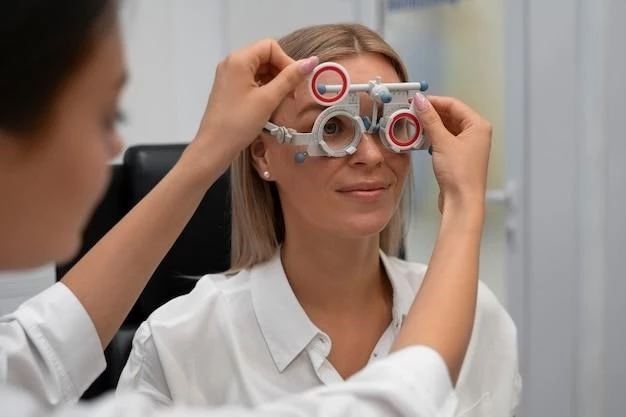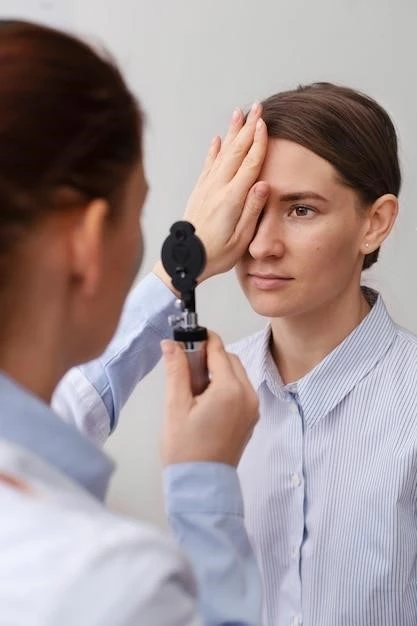This section aims to provide a comprehensive understanding of posterior uveitis, also known as choroiditis. Posterior uveitis involves inflammation of the choroid, which can impact the retina and optic nerve, potentially leading to permanent vision loss if left untreated. It is crucial to recognize the symptoms and seek prompt medical attention for accurate diagnosis and appropriate management.
Definition and Characteristics
Posterior uveitis, also known as choroiditis, is a rare form of uveitis that involves inflammation of the choroid, which is the back part of the eye’s uvea. This condition can impact the retina and optic nerve, potentially leading to permanent vision loss if not promptly diagnosed and treated. Recognizing the symptoms of posterior uveitis and seeking medical attention for proper evaluation and management are crucial steps in preserving visual health.
Causes of Posterior Uveitis
Posterior uveitis, also known as choroiditis, can have various causes, including infections like toxoplasmosis, autoimmune diseases, and inflammatory conditions. Understanding the underlying cause is crucial for initiating the appropriate treatment to manage the inflammation effectively and prevent potential vision loss.
Infectious Causes
Infections like toxoplasmosis and cytomegalovirus are common infectious causes of posterior uveitis. These infections can lead to inflammation of the choroid, impacting the retina and optic nerve. Prompt identification and treatment of the underlying infectious agent are crucial in managing posterior uveitis effectively to prevent vision loss.
Non-infectious Causes
Non-infectious causes of posterior uveitis may include autoimmune diseases, inflammatory conditions, and other systemic disorders. Conditions such as sarcoidosis, Vogt-Koyanagi-Harada syndrome, and Behçet’s disease can contribute to the development of posterior uveitis. It is essential to identify and address these underlying non-infectious causes to effectively manage and treat the inflammation in the eye.
Symptoms and Diagnosis
Recognizing common symptoms such as decreased vision and floaters is crucial. Seek prompt medical evaluation for accurate diagnosis through specialized procedures to determine the extent of inflammation and its impact on vision. Early diagnosis is key to effective treatment and preventing vision loss associated with posterior uveitis.
Common Symptoms
Common symptoms of posterior uveitis, also known as choroiditis, may include decreased or lost vision, floaters, and in some cases, flashing lights. Recognizing these symptoms early is essential for seeking timely medical attention to prevent permanent vision loss associated with posterior uveitis. It is crucial to undergo a comprehensive eye examination for accurate diagnosis and appropriate management based on the presenting symptoms.
Diagnostic Procedures
Diagnosing posterior uveitis typically involves specialized procedures aimed at evaluating the extent of inflammation in the choroid, retina, and optic nerve. Key diagnostic tools may include dilated eye examinations, optical coherence tomography (OCT), fluorescein angiography, and indocyanine green angiography. These procedures help ophthalmologists assess the severity of inflammation and its impact on vision, guiding appropriate treatment interventions for posterior uveitis.
Treatment Options
Effective management of posterior uveitis, focusing on the inflammation of the choroid, involves personalized medical therapies tailored to the specific underlying cause identified through diagnostic procedures. Physicians may recommend a combination of ocular and systemic treatments to reduce inflammation, preserve vision, and prevent complications. Surgical interventions can be considered in cases where medical management alone may not suffice. It is essential to work closely with healthcare providers to determine the most suitable treatment approach for your condition.
Medical Management
Medical management of posterior uveitis involves personalized treatment strategies tailored to the specific underlying cause identified through diagnostic procedures. Physicians may recommend ocular or systemic therapies to reduce inflammation and preserve vision. It is crucial to adhere to the prescribed treatment plan and attend regular follow-up appointments to monitor the response to treatment and adjust therapies as needed to effectively manage posterior uveitis and prevent vision loss.
Surgical Interventions
Surgical interventions may be necessary in cases of posterior uveitis where medical management alone is insufficient to control inflammation or prevent complications. Procedures such as vitrectomy or retinal surgery may be considered to address specific issues affecting the retina, choroid, or optic nerve. It is essential to discuss the potential risks and benefits of surgical interventions with your healthcare provider to make informed decisions about managing posterior uveitis effectively.
Impact on Vision
Posterior uveitis, also known as choroiditis, can lead to inflammation that affects the retina and optic nerve, potentially resulting in permanent vision loss. Understanding the impact of posterior uveitis on vision underscores the importance of timely diagnosis and appropriate treatment to mitigate these risks and preserve visual health.
Potential Vision Loss
Posterior uveitis, also referred to as choroiditis, can potentially lead to permanent vision loss as it affects the retina and optic nerve. Recognizing the symptoms and seeking prompt diagnosis and treatment from an eye care professional are essential steps in preserving vision and managing posterior uveitis effectively to prevent irreversible visual impairment.

Prognosis and Complications
Understanding the long-term prognosis of posterior uveitis and potential complications is crucial. Effective management and early intervention are key to minimizing complications and preserving vision in the face of this inflammatory condition. It is important to receive ongoing care and follow-up visits with eye care specialists to monitor your eye health and address any emerging issues promptly.
Long-term Prognosis
The long-term prognosis of posterior uveitis depends on various factors, including the underlying cause, the extent of inflammation, and the timeliness of treatment. Effective management and ongoing care can help minimize the risk of complications and vision loss associated with posterior uveitis. Regular follow-up visits with eye care specialists are essential to monitor the condition and adjust treatment as needed to maintain optimal eye health over time.
Possible Complications
Possible complications of posterior uveitis, also known as choroiditis, may include damage to the optic nerve, retinal detachment, macular edema, and cataracts. It is essential to monitor the condition regularly and address any emerging complications promptly to preserve vision and prevent further damage to the eye. Comprehensive management and consistent follow-up care can help mitigate the risks associated with posterior uveitis complications.
Epidemiology and Risk Factors
Understanding the prevalence in different populations and common risk factors associated with posterior uveitis is crucial in managing the condition effectively. Identifying the demographics most affected and recognizing key risk factors can aid in early detection, prompt treatment, and prevention of complications. It is essential to stay informed about the epidemiology and potential risk factors associated with posterior uveitis to prioritize eye health and well-being.
Prevalence in Different Populations
Posterior uveitis, along with intermediate and panuveitis, have a combined prevalence of 23 per 100٫000 adults٫ with lower occurrence in children. It is crucial to understand the distribution of posterior uveitis across populations to enhance early detection٫ prompt treatment٫ and minimize the impact of this condition on eye health.
Common risk factors associated with posterior uveitis, also known as choroiditis, include exposure to endemic regions such as Central or South America, consumption of undercooked meat, and systemic diseases like toxoplasmosis. Awareness of these risk factors is essential in recognizing potential triggers for posterior uveitis and taking preventive measures to safeguard eye health. Consultation with healthcare providers for comprehensive evaluation and tailored management is recommended for individuals with these risk factors.
Distinction from Other Forms of Uveitis
When distinguishing posterior uveitis from other forms like anterior and intermediate uveitis, understanding the specific anatomical location of inflammation in the eye is crucial. Posterior uveitis, also known as choroiditis, primarily affects the back part of the uvea, involving inflammation of the retina and optic nerve. Recognizing these distinctions is essential for tailored treatment approaches and managing the unique challenges associated with posterior uveitis effectively.
Common Risk Factors
Common risk factors associated with posterior uveitis, also known as choroiditis, include exposure to endemic regions such as Central or South America, consumption of undercooked meat, and systemic diseases like toxoplasmosis. Understanding these risk factors is essential in recognizing potential triggers for posterior uveitis and taking preventive measures to safeguard eye health. Consultation with healthcare providers for tailored management is recommended.
Intermediate Uveitis
Intermediate uveitis involves inflammation in the vitreous, the jelly-like substance in the eye, and is distinct from posterior uveitis, which affects the back part of the eye, including the choroid. Recognizing the anatomical differences between intermediate and posterior uveitis is crucial for accurate diagnosis and tailored treatment strategies. If you experience symptoms of uveitis, including floaters and vision changes, consult an eye care professional for proper evaluation and management.
Panuveitis
Panuveitis refers to inflammation that affects all layers of the eye, involving the front, middle, and back parts of the eye. This condition is distinct from posterior uveitis, which primarily affects the back part of the eye, including the retina and optic nerve. Understanding the differences between panuveitis and posterior uveitis is crucial for accurate diagnosis and targeted treatment strategies to manage inflammation effectively and preserve eye health. If you experience symptoms suggestive of panuveitis, such as eye pain, redness, or vision changes, it is recommended to consult with an eye care specialist for proper evaluation and care.
Research and Advancements
Recent studies have focused on innovative treatments for intermediate, posterior, and panuveitis to enhance patient outcomes and quality of life. Advancements in understanding the prevalence and anatomical distinctions within uveitis subtypes have guided researchers in developing targeted therapies to address specific inflammatory processes affecting the eye. Stay informed about emerging treatments and advancements in uveitis management to make informed decisions about your eye health.
Recent Studies
Ongoing research in uveitis treatment has focused on advancements in targeting specific inflammatory processes associated with intermediate, posterior, and panuveitis. Emerging therapies aim to improve patient outcomes by addressing the unique challenges of uveitis subtypes. Staying informed about recent studies and advancements in uveitis management can help individuals make well-informed decisions about their eye health and treatment options.
Emerging Treatments
Recent advancements in the treatment of intermediate, posterior, and panuveitis have shown promising results in targeting specific inflammatory processes within the eye. Emerging treatments are aimed at improving patient outcomes by addressing the unique challenges associated with different types of uveitis. It is crucial to stay updated on these cutting-edge therapies to make informed decisions about managing posterior uveitis and other uveitic conditions effectively.

Global Impact and Market Trends
The Global Ocular Inflammation Treatment Market is on the rise, expected to grow significantly in upcoming years. Keeping abreast of market trends in uveitis treatment can help individuals stay informed about the latest developments and access innovative therapies to manage posterior uveitis effectively. It is essential to stay informed about the evolving landscape of uveitis treatment to make informed decisions about your eye health.
Ocular Inflammation Treatment Market
The Global Ocular Inflammation Treatment Market is experiencing substantial growth, with projections indicating a significant increase in the coming years. Staying informed about market trends in uveitis treatment is essential for individuals seeking effective management of posterior uveitis. Keeping abreast of market developments can provide valuable insights into the availability of innovative therapies and options for preserving eye health.
Conclusion and Recommendations
In conclusion, managing posterior uveitis, whether as part of intermediate or panuveitis, requires a tailored approach to treatment. Stay informed about emerging therapies and market trends in uveitis management to make informed decisions about your eye health. Seeking prompt medical attention, adhering to treatment plans, and regular follow-up care are essential in preserving vision and mitigating the impact of posterior uveitis. Remember to consult with eye care specialists for personalized recommendations and to prioritize your eye health.
